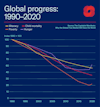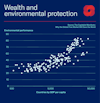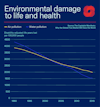 Jenna Shrove
Jenna Shrove
Former Executive Director of Strategic Advocacy and Advisor to the Chief Policy Officer
Published
January 18, 2024
While naysayers may say otherwise, free enterprise and free markets have improved economic mobility, equality, safety, production, life expectancy, and overall happiness across the globe for years.
The myths and facts on free markets explained below are highlights from Johan Norberg’s “The Capitalist Manifesto: Why the Global Free Market Will Save the World.” These statistics aren't just numbers—they represent lives changed, opportunities created, and problems solved for people all over the world.
Economic Mobility and Inequality
Myth: Those born into the lower income quintiles face a daunting challenge to move up the economic ladder.
The 2026 State of American Business
Discover what U.S. Chamber President and CEO Suzanne Clark and leading business leaders are saying about the state of the economy and the top issues shaping the domestic and global business landscape in 2026 and beyond.
Free Market Fact: The chance of upward mobility remains strong.
- Recent data shows that among Americans born in the lowest quintile, 37% rise to one of the three highest quintiles. Even in the second lowest quintile, nearly half successfully climbed the economic ladder.
Myth: The American middle class is shrinking due to a decline in prosperity.
Free Market Fact: The common narrative of a shrinking middle class is actually a result of upward mobility.
- Individuals once considered part of the middle class have moved into higher income brackets, challenging the traditional understanding of class dynamics.
Myth: Those in the top quintile earn 16.7 times more than those in the bottom quintile.
Free Markets Fact: When accounting for taxes and transfers, the income gap is reduced from 16.7 times to a more modest four times.

Myth: Scandinavian countries like Sweden and Denmark have better economic mobility and equality.
Free Market Fact: The comparison often overlooks the fundamental differences in wage structures.
- In Scandinavian countries, where wages are more compressed, a modest increase in income can propel individuals to a higher quintile. In the U.S., the bar is set higher, requiring a more substantial income boost for upward mobility.
Myth: Dynastic wealth is perpetuated through generations.
Free Markets Fact: Looking at the Forbes 400 in 1982, only 69 individuals or their heirs retained their positions in 2014.
Stand Up for Free Enterprise
Join us in supporting American free enterprise.
Your voice is essential, and your participation is critical.
Global Improvements
Free Markets Fact: Over the last twenty years, our world has witnessed a remarkable transformation—a reduction of 70% in extreme global poverty.
- Each day, a staggering 138,000 people have risen out of extreme poverty.

Free Markets Fact: There are many other numbers that tell a compelling story of progress and positive change on a global scale over the last 20 years.
- Global life expectancy increased from 64 years to almost 73 years.
- Illiteracy dropped from 25.7% to 13.5%.
- Child labor (5-17) decreased from 16% to just under 10%.
Production, Globalization, and the Workplace
Myth: American manufacturing has been wiped out with companies moving jobs overseas.
Free Markets Fact: American industrial production has doubled since 1980.
- American manufacturing has produced more due to improved production processes, despite shedding jobs.
- Over the past few decades, wages at every income level have increased by 50%, American industry expanded its output by more than half, and unemployment fell to record lows.
Myth: China is taking away American jobs.
Free Markets Fact: American companies that work with Chinese imports have grown their workforce by 2% or more per year compared to their counterparts.
- Jobs were added not just in production lines but also in higher-skilled, better-paying jobs in the company.
Free Markets Fact: The safety of American workplaces has seen significant improvements.
- In 1972, there were 10.9 workplace injuries per 100 workers. Fast forward to 2019, and this number has dropped dramatically to just 2.8. This remarkable decline underscores the strides made in ensuring the well-being of the American workforce.
Concentration and Monopoly
Myth: Industrial concentration leads to a rise in stagnant monopolies dominating our markets.
Free Markets Fact: Stagnant monopolies do not dominate our markets. The U.S. has acomplex and ever-evolving dynamic business landscape. Companies rise and fall in an ecosystem of competition and innovation, ultimately driving economic growth.
- In 2020, only 51 companies on the Fortune 500 list were there since its inception in 1955.
- The average duration businesses spend on the S&P 500 has decreased by over 40% since 1970, plummeting from around 35 years to approximately 20 years today.
Free Markets Fact: Each year there are thousands of mergers in the U.S., which strengthens our economy.
- Mergers play a crucial role in enhancing global competitiveness, improving products and services, and fostering efficiencies that ultimately benefit consumers.
Free Markets Fact: For over four decades, the U.S. has maintained a bipartisan consensus in favor of market-based competition and antitrust enforcement, guided by the consumer welfare standard and robust economic analysis.
These past headlines highlight the constant churn:
- “’Will the dominant social network of our time ever lose its monopoly?... Users have invested so much social capital in putting up data about themselves it is not worth their changing sites.’” - The Guardian in 2007 describing MySpace.
- “How Yahoo! won the search wars.” - Fortune Magazine in 1998.
- “One billion customers. Can anyone catch the cell phone king?” – Forbes in 2007 describing Nokia.
The Environment
Myth: Economic growth hurts the environment.
Free Markets Fact: In our interconnected world, it's the faster-growing, wealthier nations that have spearheaded advancements in processes and technologies and transportation that reduce waste and environmental impact.
- Wealthier nations have a strong track record of minimizing plastic pollution. The rigorous waste management systems in place significantly limit the amount of plastic ending up in nature or oceans.
- If every citizen in Europe and America were to completely halt their use of plastic, the impact on plastic emissions into the oceans would be negligible—underscoring the need for a broader, global approach.

Free Markets Fact: The global effort to address the health and environmental consequences of pollution has seen substantial progress.
- From 1990 to 2017, life years lost to air pollution decreased by 49%, while water pollution-related life years lost dropped by an even more substantial 65%.

Happiness, Culture Wars, and Capitalism
Myth: Free markets may be efficient and may create growth, but it is at the expense of the happiness and well-being of those at the bottom of the income ladder.
Free Markets Fact: Free markets become a beacon of autonomy and freedom of choice, particularly for low-income earners, offering them avenues to exercise choice and control in their lives.
- The significance of this effect diminishes for high-income earners, as their financial standing already affords them many choices.

Free Markets Fact: Capitalism contributes to the creation of growing societies that offer greater opportunities for all groups to embrace and express their unique identities. It paints a picture of a world where diverse visions and projects find room to flourish within the framework of a thriving capitalist society.
- In a world increasingly susceptible to culture wars, it is a zero-sum game to impose a single, homogeneous identity on everyone, which contrasts sharply with the positive-sum game of capitalism.
About the authors

Jenna Shrove
Jenna Shrove is the former Executive Director of Strategic Advocacy and Former Advisor to the Chief Policy Officer at the U.S. Chamber of Commerce.

Lindsay Burton
Lindsay (Cates) Burton is a director on the communications team. She leads strategic communications for member marketing partnerships and small business advocacy programs. She previously worked as a writer and editor at U.S. News and World Report.







